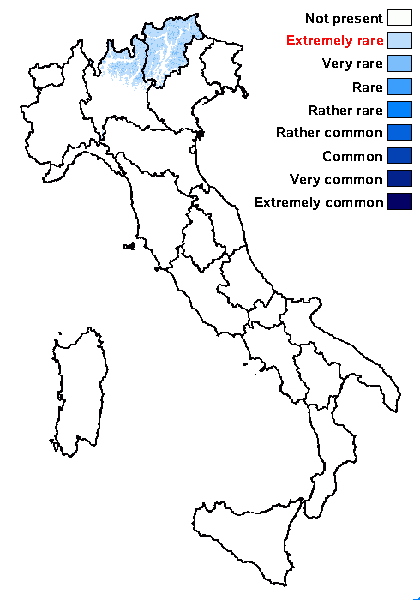Halecania alpivaga (Th. Fr.) M. Mayrhofer
Herzogia, 7: 391, 1987. Basionym: Lecania alpivaga Th. Fr. - Lichenogr. Scand., 1: 292, 1871.
Synonyms: Lecania thallophila H. Magn.
Distribution: N - TAA, Lomb.
Description: Thallus crustose, episubstratic, pale grey to brown-grey, consisting of scattered areoles or granules, usually starting the life-cycle on cyanobaterial lichens. Apothecia lecanorine, 0.2-0.8 mm across, at first subglobose and almost perithecioid, then with an expanded, dark brown to black, flat to convex disc, a thin, persistent, entire thalline margin, and an evident parathecial ring. Thalline exciple corticate, with anticlinally oriented hyphae, those in the upper part often with a brown cap; proper exciple paraplectenchymatous, dark brown in outer part, paler within; epithecium brown, with a brown epipsamma; hymenium colourless, 55-75 µm high, I+ blue; paraphyses branched in upper part, the apical cells clearly swollen, with a dark cap; hypothecium colourless. Asci 8-spored, clavate to subcylindrical, with a K/I+ blue outer coat and a K/I+ uniformly blue apical dome, Catillaria-type. Ascospores 1-septate, hyaline, ellipsoid, 13-17(-22) x 5-7 µm including the gelatinous perispore. Pycnidial wall brown in upper part, colourless in lower part. Conidia hyaline, bacilliform. Photobiont chlorococcoid. Spot tests: thallus K-, C-, KC-, P-, UV-. Chemistry: without lichen substances.Note: a cool-temperate to arctic-alpine species found on weakly calciferous and basic siliceous rocks in humid situations, mostly in upland areas, often on the thalli of Physcia, Collemataceae and Placynthium; probably more widespread in the Alps.
Growth form: Crustose
Substrata: rocks
Photobiont: green algae other than Trentepohlia
Reproductive strategy: mainly sexual
paras
Commonnes-rarity: (info)
Alpine belt: extremely rare
Subalpine belt: very rare
Oromediterranean belt: absent
Montane belt: extremely rare
Submediterranean belt: absent
Padanian area: absent
Humid submediterranean belt: absent
Humid mediterranean belt: absent
Dry mediterranean belt: absent

Predictive model
Growth form: Crustose
Substrata: rocks
Photobiont: green algae other than Trentepohlia
Reproductive strategy: mainly sexual
paras
Commonnes-rarity: (info)
Alpine belt: extremely rare
Subalpine belt: very rare
Oromediterranean belt: absent
Montane belt: extremely rare
Submediterranean belt: absent
Padanian area: absent
Humid submediterranean belt: absent
Humid mediterranean belt: absent
Dry mediterranean belt: absent

Predictive model
 INDEX FUNGORUM
INDEX FUNGORUM
 GBIF
GBIF
 DOLICHENS
DOLICHENS

